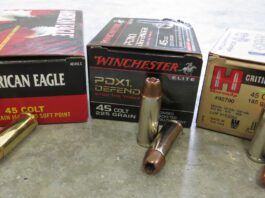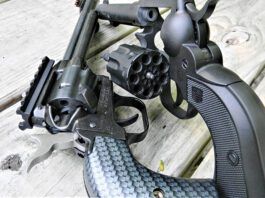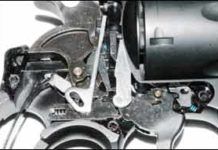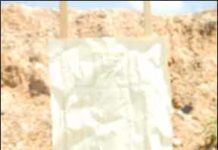Charter Arms Introduces 9mm Rimless Revolver Pitbull
Cabela’s 1851 Navy .36 Percussion, $120
Wild Bill had a pair. Sam Bass used one, and so did Frank James and Cole Younger. Elmer Keith liked his very much. In fact, Elmer's 1851 Navy Colt was one of his first handguns, and it undoubtedly influenced the grand old master all his life. With all this popularity Gun Tests Magazine thought it would be a good idea to inform its readers where to go to get today's best copy of the breed.
.410 Handguns and Long Guns To Consider for Self Defense
After reading the test of .410-bore shotshells adjacent, shooters may wonder what guns are good choices to shoot the small-gauge self-defense rounds. While we can't attest to how a given gun will work with a given shell, we can recommend some firearms that generally suit the .410 shotshell in home-defense situations.
About a year ago, Ray Ordorica compared two handguns chambered for the .410 shotshell, the S&W Governor 45 ACP, 45 LC, 410/2.5-inch, $679; and the Taurus Judge Model 4510TKR-3BUL 45 LC/410 2.5-inch, $620. We learned back then that these handguns performed better with smaller shot. Ray first patterned the Gov at 3 yards, which gave a pattern with Winchester Super-X No. 7.5 shot that fit onto a sheet of 8.5-inch x 11-inch paper. At 5 yards from the muzzle, the pattern with the Governor spread to about 18 inches. This was far superior to what we got with shot loads from the Judge, he reported, which would spread to about a foot at only 3 feet. The same held true with the #4 shot. The Governor's pattern slightly overlapped a sheet of paper with a spotty pattern fired from 9 feet, but at that same range the Judge barely struck the paper. At 15 feet, the pattern differences were astounding. The Smith Governor put all its shot into a 17-inch circle. The Judge put its shot into a 34-inch circle, twice the diameter. The Judge's pattern had many holes, but the Governor's pattern was even, and quite impressive. The shotshell results very much favored the Smith & Wesson.
With 000 buck from 20 feet, the results from both guns were spotty. He concluded the maximum range for 000 buck is about 20 feet.
Options for Concealed Carry: Two Nines Vs. a Forty Wheelgun
When it comes to concealing a handgun, there is only so much space available on the hip, inside a handbag, or somewhere else on the body or in clothing. That's why there are snubnosed revolvers and subcompact pistols. Choosing a handgun, then, becomes a balance of firepower versus weight and overall structural dimensions. In this test, we will limit the size of our test guns to three guns that will fit into a box approximately 5-by-7 inches in size — which represents a handgun that can be carried easily in just about any manner of traditional concealment.
However, we are purposefully mixing apples and oranges, that is, pistols and revolvers, because either design can do the job of self-protection at close range. Our three test guns were the $747 9mm Kimber Solo Carry, the $299 9mm SCCY Industries CPX-2, and the $523 Taurus 40 S&W M405 stainless-steel revolver. Each gun offered at least one advantage not shared by the other two. The Kimber Solo was the most concealable. The SCCY pistol offered the highest capacity, and the Taurus revolver fired the biggest bullet.
The cartridge versus cartridge debate rages on, largely based on the stopping power of one single shot. But let us offer an alternative viewpoint suggested by TacPro Shooting Center's Bill Davison. Davison, a former Royal Marine and one of the most complete training consultants in the United States, offers that when rating the firepower of a handgun, the amount of energy it can deliver should be the sum of its entire capacity rather than the energy of one lone shot. For example, a 9+1 capacity pistol, wherein each bullet registers about 330 foot-pounds of energy at the muzzle, should ultimately be considered more powerful than a six-shot pistol that fires ammunition capable of delivering 500 foot-pounds with each round of fire. Food for thought.
For our tests, we began by shooting five-shot groups (the capacity of the Taurus) from the 15-yard bench. Then, we applied what we think was a more realistic test. Each gun was fired from a distance of 5 yards at a humanoid paper target. Start position was with the gun lowered to rest on a oil-barrel top about waist high. We used a CED8000 shot-activated timer to provide a start signal and record elapsed time of each shot. We took note of the first shot to see how fast we could get the gun into action and the last shot to see how long it took to deliver two shots to center mass and one shot to the head area. Altogether we recorded five separate strings of fire. We scored the hits A, B, C, or D, looking for ten hits to the preferred 5.9-inch by 11.2-inch A-zone at center mass and five hits to the A-zone in the head, which measured 4 inches long by 2 inches high. The catch was that the test was performed strong hand only. (By a right-handed shooter holding the gun with only his right hand). We weren't trying to be cowboys or go Hollywood. It's just that in close-range fighting where guns such as these would most likely be used, applying a support hand may not be possible. On the semiautos, there wasn't much room for a support hand in the first place.
For testing the Taurus revolver, we chose Winchester 165-grain FMJ ammunition sold in a value pack, Federal Premium 135-grain Hydra Shok JHP ammunition, and Hornady Custom 180-grain XTP jacketed hollowpoint rounds. The 165-grain rounds were also used in our action shooting test. For testing the semi-automatics, we ended up using four test rounds. After testing with 115-grain FMJ, 115-grain JHP EXP hollowpoints, and 124-grain JHP rounds from Black Hills Ammunition, we learned that Kimber had declared that the Solo should only be used with 124-grain and 147-grain bullets. So, we went back to the test range with a supply of Federal 147-grain Federal Hydra Shok ammunition and resumed our bench session. Naturally, we retested the SCCY pistol with the 147-grain ammunition as well. All test rounds were standard pressure, including the Black Hills EXP ammunition, which was designed for maximum performance in firearms not recommended for +P ammunition. Here is what we learned.
GunAuction to Watch: Colt’s PT. F.A. Mfg. Co. — Single Action Army Artillery Model...
Different Firing Pin Designs: What They’re Called, How They Work
Everybody knows firing pins detonate primers, but not everyone can define esoteric aspects of these parts.
GunReports.com Video: Thompson Machine’s Suppressor Lineup
GunAuction to Watch: 1926 Smith & Wesson .44 Sp Hand Ejector, 2nd Model Target...
An Inside Look at the Webley Mark VI Revolver
Smith & Wesson 10mm Model 610
Although there may not be a big selection of the more powerful 10mm rounds, the wide variety of available .40 S&W rounds makes the 610 an appealing weapon. Accuracy was exceptional.



































